
The European spadefoot toads are a family of frogs, the Pelobatidae, with only one extant genus Pelobates, containing six species. They are native to Europe, the Mediterranean, northwestern Africa, and western Asia.

The Scaphiopodidae are a family of American spadefoot toads, which are native to North America. The family is small, comprising only seven different species.

Spea hammondii, also known as the western spadefoot, western spadefoot toad, Hammond's spadefoot, or Hammond's spadefoot toad, is a species of amphibian in the family Scaphiopodidae. It is found in western California (USA) and northwestern Baja California (Mexico). The specific name hammondii is in honor of physician and naturalist William Alexander Hammond.

The Texas toad is a species of medium-sized toad that occurs in the southern United States and northern Mexico. It breeds in temporary water pools after heavy rains.
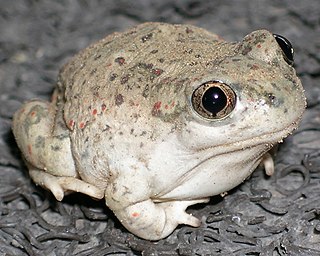
The New Mexico spadefoot toad is a species of American spadefoot toad found in the southwestern United States and Mexico. Like other species of spadefoot toad, they get their name from a distinctive spade-like projections on their hind legs which enable them to dig in sandy soils. Spea multiplicata can be identified by its wedge-shaped spade. Some sources also refer to the species as the Mexican spadefoot toad, desert spadefoot toad or southern spadefoot toad.

Boettger's horned toad, also known as Boettger's spadefoot toad or the pale-shouldered horned toad, is a species of toad found in southern and southeastern China and north-eastern India. A closely related but probably as yet undescribed species in found in Tibet.
The Amatola toad is a species of toad in the family Bufonidae. It is endemic to the Eastern Cape province, South Africa, where it is known from the Winterberg and Amathole Mountains. The specific name refers to the type locality, "Amatola Range, near Hogsback".

Sclerophrys perreti is a species of toad in the family Bufonidae. It is endemic to the Idanre Hills in southwestern Nigeria. Sclerophrys perreti is one of the frogs declared as "Lost" in 2010. However, it was re-discovered at its type locality in 2013. Before that, it had not been seen—possibly—since 1970, and with certainty, since 1963. Common name Perret's toad has been coined for it.
Sclerophrys reesi, also known as Merara toad or Rees' toad, is a species of toad in the family Bufonidae. It is endemic to southern Tanzania and is only known from the Kihansi–Ulanga River floodplain from elevations of 200–500 m (660–1,640 ft) above sea level. It is named after Allen Rees, a principal game warden for the Tanzanian Wildlife Department who collected the type series.
Werneria tandyi, also known as Tandy's torrent toad or Tandy's smalltongue toad, is a species of toad in the family Bufonidae. It is endemic to western Cameroon and known from Mount Manengouba and from the Rumpi Hills. The specific name tandyi honours Robert Mills Tandy, biologist, herpetologist, and wildlife photographer.

Annam tree frog, also known as the South China tree toad, is a species of frog in the family Hylidae. It is found in southern China, Vietnam, and Laos. The Hainan tree toad from Hainan Island is treated as a subspecies.
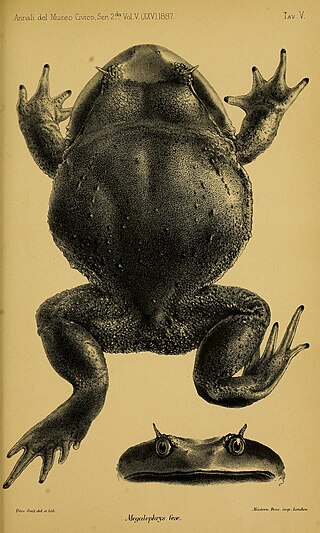
Brachytarsophrys feae is a species of amphibian in the family Megophryidae. It is found in southern China and northern Myanmar, Thailand, and Vietnam; it is likely to occur in Laos. The specific name feae honors Leonardo Fea, an Italian explorer, zoologist, and naturalist.

Leptobrachium hendricksoni is a species of amphibian in the family Megophryidae. It is found in Malay Peninsula, Sarawak (Borneo), and Sumatra (Indonesia). Its natural habitats are tropical moist lowland forests, rivers, freshwater marshes, and nearby plantations and heavily degraded former forests. It is threatened by habitat loss.

Leptobrachium montanum is a species of frog from the family Megophryidae. It is endemic to Borneo and is, as currently defined, found in Kalimantan (Indonesia), Sabah and Sarawak (Malaysia), and Labi, Belait (Brunei). However, the nominal Leptobrachium montanum is a composed of more than one lineage. Available information mostly refers to this composite rather than the "true" Leptobrachium montanum. Common names montane large-eyed litter frog, mountain spadefoot toad, and mountain litter frog have been coined for it.
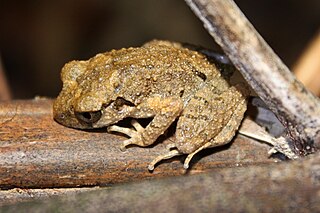
Leptobrachella liui, also known as Fujian Asian toad or Fujian metacarpal-tubercled toad, is a frog species in the family Megophryidae. Originally described from Chong'an in Fujian, it is now known to be widely distributed in southern and southeastern China from Zhejiang and Fujian west to Guizhou and Guangxi.

Xenophrys aceras, commonly known as the Perak horned toad, Perak spadefoot toad or Malayan horned frog, is a species of frog in the family Megophryidae found in Peninsular Malaysia and Thailand, and possibly in Indonesia. Its common name refers to its type locality, Bukit Besar in Perak state, Malaysia.

Xenophrys longipes is a species of frog in the family Megophryidae. It is also known as the Malacca spadefoot toad, red legged spine-eyed frog, red-legged horn frog, and slender-legged horned frog. It is found in the Malay Peninsula. Records from Cambodia and Vietnam are considered doubtful.
The rough-skinned horned toad or Tonkin spadefoot toad is a species of frog in the family Megophryidae. It is found in southern China, northern Vietnam, and northern Laos.
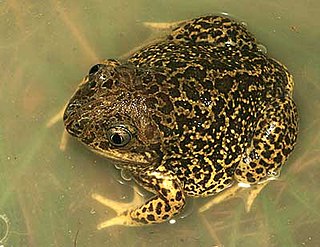
Pelobates cultripes is a toad species in the family Pelobatidae. It is known under many different common names, including the western spadefoot, Iberian spadefoot toad, Spanish spadefoot toad, and Wagler's spadefoot toad. It is found in most of the Iberian Peninsula with isolated populations southern and western France.
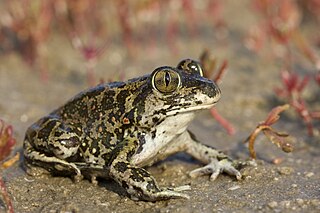
Pelobates syriacus, the eastern spadefoot or Syrian spadefoot, is a species of toad in the family Pelobatidae, native to an area extending from Eastern Europe to Western Asia.















